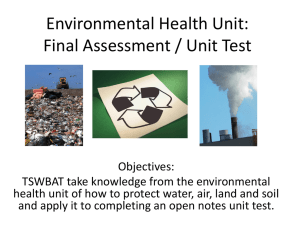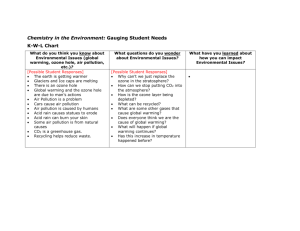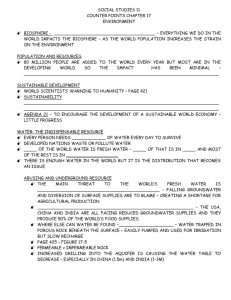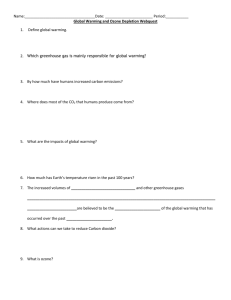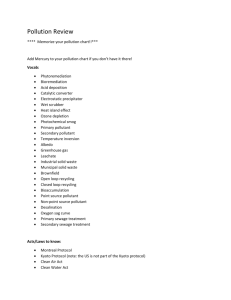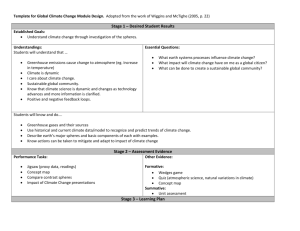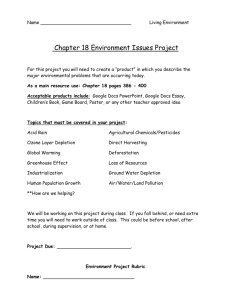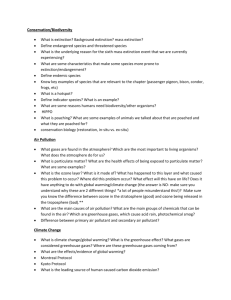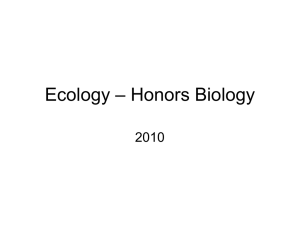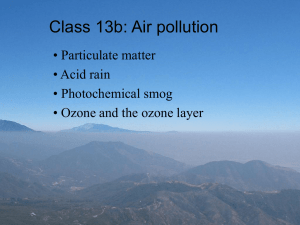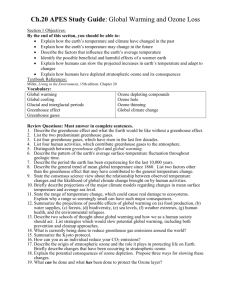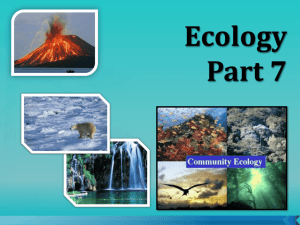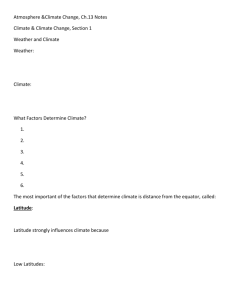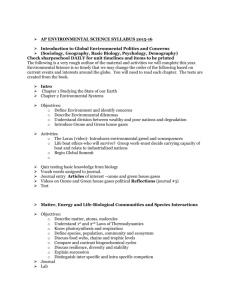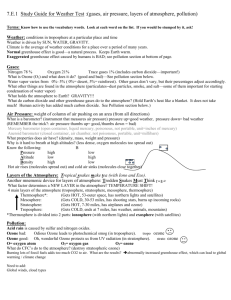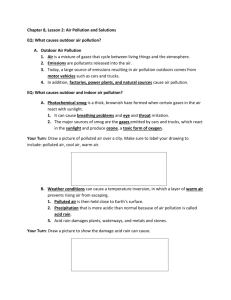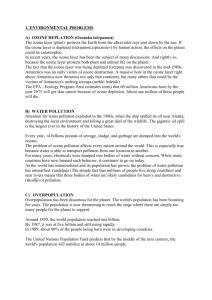Semester-Exam-study-guide
advertisement
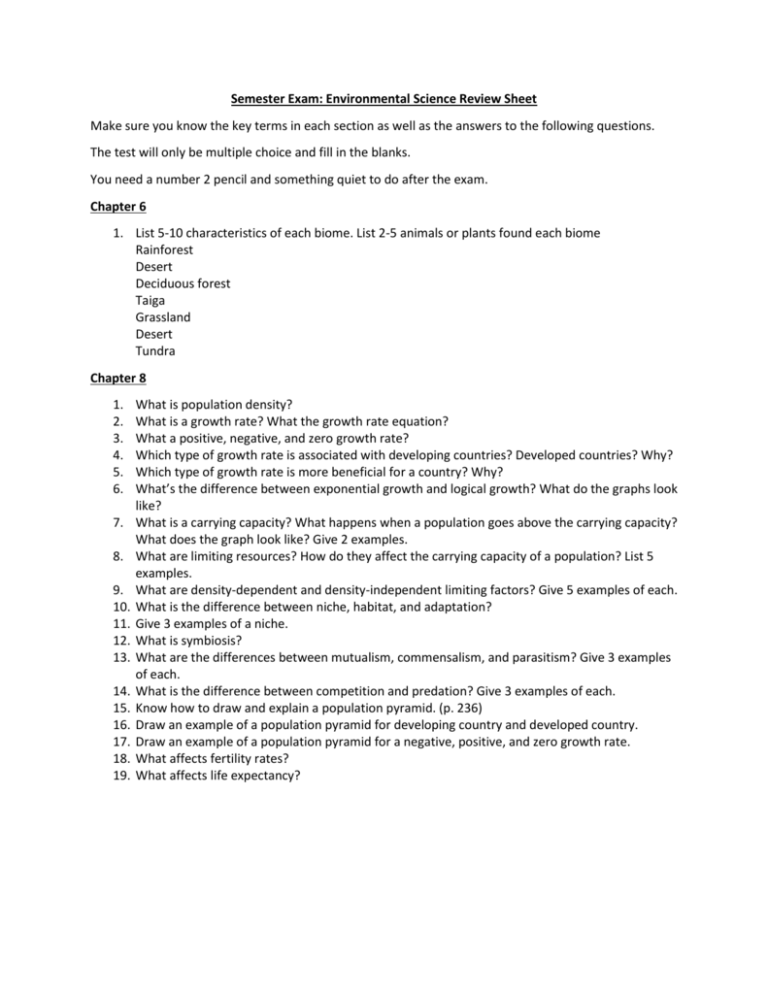
Semester Exam: Environmental Science Review Sheet Make sure you know the key terms in each section as well as the answers to the following questions. The test will only be multiple choice and fill in the blanks. You need a number 2 pencil and something quiet to do after the exam. Chapter 6 1. List 5-10 characteristics of each biome. List 2-5 animals or plants found each biome Rainforest Desert Deciduous forest Taiga Grassland Desert Tundra Chapter 8 1. 2. 3. 4. 5. 6. 7. 8. 9. 10. 11. 12. 13. 14. 15. 16. 17. 18. 19. What is population density? What is a growth rate? What the growth rate equation? What a positive, negative, and zero growth rate? Which type of growth rate is associated with developing countries? Developed countries? Why? Which type of growth rate is more beneficial for a country? Why? What’s the difference between exponential growth and logical growth? What do the graphs look like? What is a carrying capacity? What happens when a population goes above the carrying capacity? What does the graph look like? Give 2 examples. What are limiting resources? How do they affect the carrying capacity of a population? List 5 examples. What are density-dependent and density-independent limiting factors? Give 5 examples of each. What is the difference between niche, habitat, and adaptation? Give 3 examples of a niche. What is symbiosis? What are the differences between mutualism, commensalism, and parasitism? Give 3 examples of each. What is the difference between competition and predation? Give 3 examples of each. Know how to draw and explain a population pyramid. (p. 236) Draw an example of a population pyramid for developing country and developed country. Draw an example of a population pyramid for a negative, positive, and zero growth rate. What affects fertility rates? What affects life expectancy? Chapter 11 1. 2. 3. 4. 5. 6. 7. 8. 9. 10. 11. 12. 13. 14. 15. 16. 17. 18. 19. Describe the water cycle Where is fresh water located on Earth? Where do we get the water that we use? What is surface water? What is groundwater? What is a watershed? What is an aquifer? What is the difference between porous and permeability? What is beneficial when talking about our groundwater? What are the 3 major uses for water? What are ways the 3 major uses for water conserve water? What is the relationship between pathogen and potable water? How do we determine the location of point and non point pollution? Give 5 examples of point and non-point pollution? What is the problem with artificial eutrophication? What is the problem with thermal pollution? Example the importance of dams. Explain ways of getting drinkable water: desalination, transporting water, and towing ice caps. What is wastewater? What are issues with oil spills? What are ways to stop water pollution? Chapter 13 1. 2. 3. 4. 5. 6. 7. 8. 9. 10. 11. 12. 13. 14. 15. 16. 17. 18. 19. 20. What is the difference between climate and weather? What factors determine climate? How have researchers determine the climate and atmospheric gases from the past? What are the differences and similarities between El Nino and La Nina What are the different factors that affect the type of climate is in an ecosystem or biome? How do we have seasons? What are CFC’s? How do they affect the ozone layer? Help create the ozone hole? Describe the ozone hole and how it was formed. What is the difference between ozone above the stratosphere and ozone in the troposphere? How do UV waves affect humans? Animals? Plants? Bacteria? How are we protecting the ozone layer? Nationally? Globally? What is the greenhouse effect? What are the greenhouse gases? How are they put in the air? Who was Charles Keeling? How did he contribute to our understanding of global warming? What will happen with an increasing amount of greenhouse gases on Earth? What are the effects of climate change now? What is global warming? How does it affect us? List 10 consequences of a warmer Earth. List 5 ways that we can stop global warming. What is the IPPCC? What is TAR? What did they do to help with climate change? What is the Kyoto Protocol? Why is this important?
